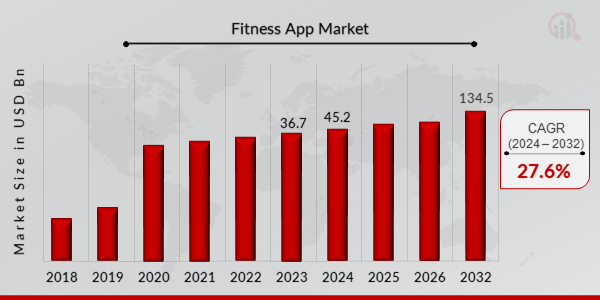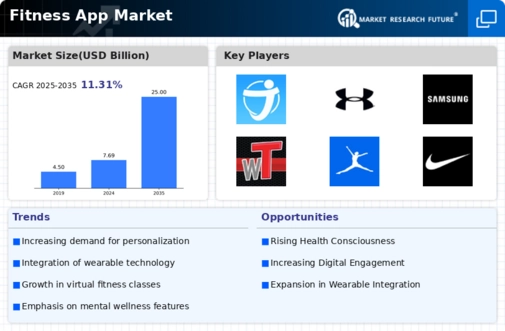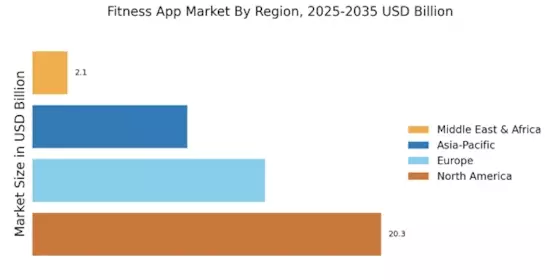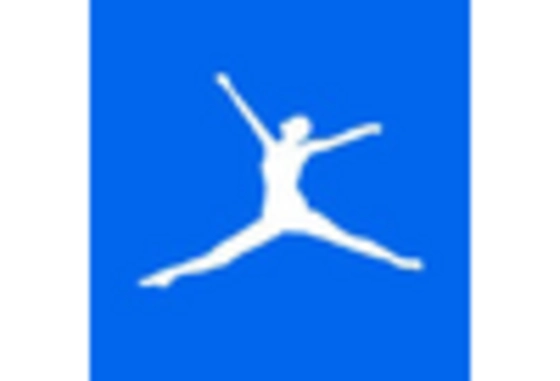The Fitness App Market is currently characterized by a dynamic competitive landscape, driven by technological advancements and an increasing consumer focus on health and wellness. Major players such as MyFitnessPal (US), Fitbit (US), and Strava (US) are strategically positioned to leverage their brand equity and user engagement. MyFitnessPal (US) has been focusing on enhancing its user experience through personalized nutrition plans and community features, which appears to resonate well with its user base. Meanwhile, Fitbit (US) continues to innovate with its wearable technology, integrating advanced health metrics into its app, thereby reinforcing its position as a leader in health tracking. Strava (US), on the other hand, emphasizes community engagement and social features, which seem to attract a dedicated user base of fitness enthusiasts. Collectively, these strategies contribute to a competitive environment that is increasingly centered around user engagement and technological integration.
In terms of business tactics, companies are increasingly localizing their offerings to cater to diverse consumer preferences across different regions. This localization, coupled with supply chain optimization, is becoming essential as companies strive to enhance their operational efficiency. The market structure appears moderately fragmented, with several key players vying for market share. However, the influence of major companies like MyFitnessPal (US) and Fitbit (US) is substantial, as they set benchmarks for innovation and user engagement that smaller players often strive to emulate.
In August 2025, MyFitnessPal (US) announced a partnership with a leading nutrition science organization to provide users with evidence-based dietary recommendations. This strategic move is likely to enhance the app's credibility and attract health-conscious consumers seeking reliable nutritional guidance. By aligning with a reputable organization, MyFitnessPal (US) not only strengthens its market position but also differentiates itself in a crowded marketplace.
In September 2025, Fitbit (US) launched a new feature that integrates AI-driven coaching into its app, offering personalized workout plans based on user data. This innovation is significant as it positions Fitbit (US) at the forefront of the digital fitness revolution, appealing to users who seek tailored fitness solutions. The incorporation of AI technology may also enhance user retention, as personalized experiences are increasingly valued in the fitness app sector.
In October 2025, Strava (US) introduced a subscription model that includes exclusive access to advanced analytics and training plans. This strategic pivot towards a subscription-based revenue model indicates a shift in focus towards monetization strategies that leverage user data. By offering premium features, Strava (US) not only enhances its revenue potential but also fosters a sense of community among serious athletes who are willing to invest in their training.
As of October 2025, the Fitness App Market is witnessing trends that emphasize digitalization, sustainability, and the integration of AI technologies. Strategic alliances are increasingly shaping the competitive landscape, as companies recognize the value of collaboration in enhancing their service offerings. Looking ahead, competitive differentiation is likely to evolve from traditional price-based competition to a focus on innovation, technological advancements, and supply chain reliability. This shift suggests that companies that prioritize user experience and technological integration will be better positioned to thrive in an increasingly competitive market.


















Leave a Comment